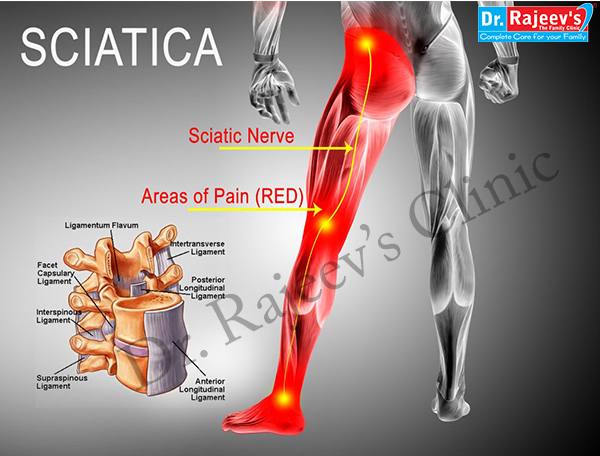

Sciatica refers to pain that radiates along the path of the sciatic nerve, which branches from our lower back through our hips and buttocks and down each leg. Typically, sciatica affects only one side of our body.
Sciatica most commonly occurs when a herniated disk, bone spur on the spine or narrowing of the spine (spinal stenosis) compresses part of the nerve. This causes inflammation, pain and often some numbness in the affected leg.
Although the pain associated with sciatica can be severe, most cases resolve with non-operative treatments in a few weeks.

Pain that radiates from our lower (lumbar) spine to our buttock and down the back of our leg is the hallmark of sciatica. one might feel the discomfort almost anywhere along the nerve pathway, but it is especially likely to follow a path from our low back to our buttock and the back of our thigh and calf.
The pain can vary widely, from a mild ache to a sharp, burning sensation or excruciating pain. Sometimes it can feel like a jolt or electric shock. It can be worse when we cough or sneeze, and prolonged sitting can aggravate symptoms. Usually only one side of our body is affected.
Some people also have numbness, tingling or muscle weakness in the affected leg or foot. One might have pain in one part of their leg and numbness in another part.
Sciatica occurs when the sciatic nerve becomes pinched, usually by a herniated disk in our spine or by an overgrowth of bone (bone spur) on our vertebrae. More rarely, the nerve can be compressed by a tumor or damaged by a disease such as diabetes.
Risk factors
Risk factors for sciatica include
Although most people recover fully from sciatica, often without treatment, sciatica can potentially cause permanent nerve damage. Seek immediate medical attention if there are following condition.
It is not always possible to prevent sciatica, and the condition may recur. The following can play a key role in protecting our back.
Gnaphalium, Colocynth, Hypericum, Caulophyllum, RL-15